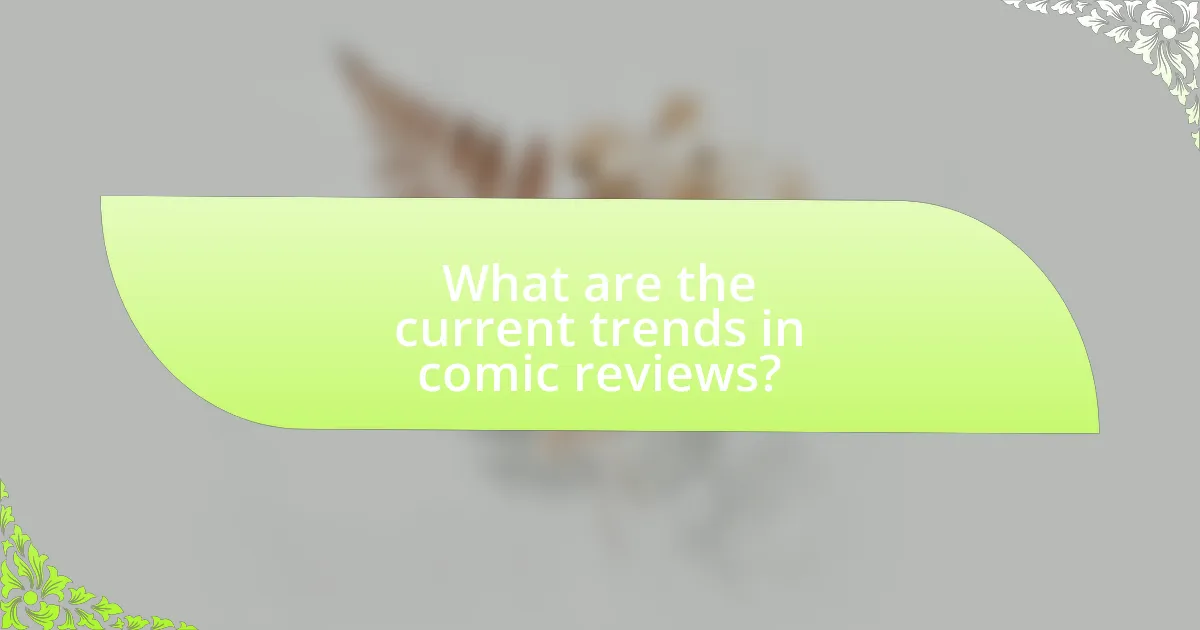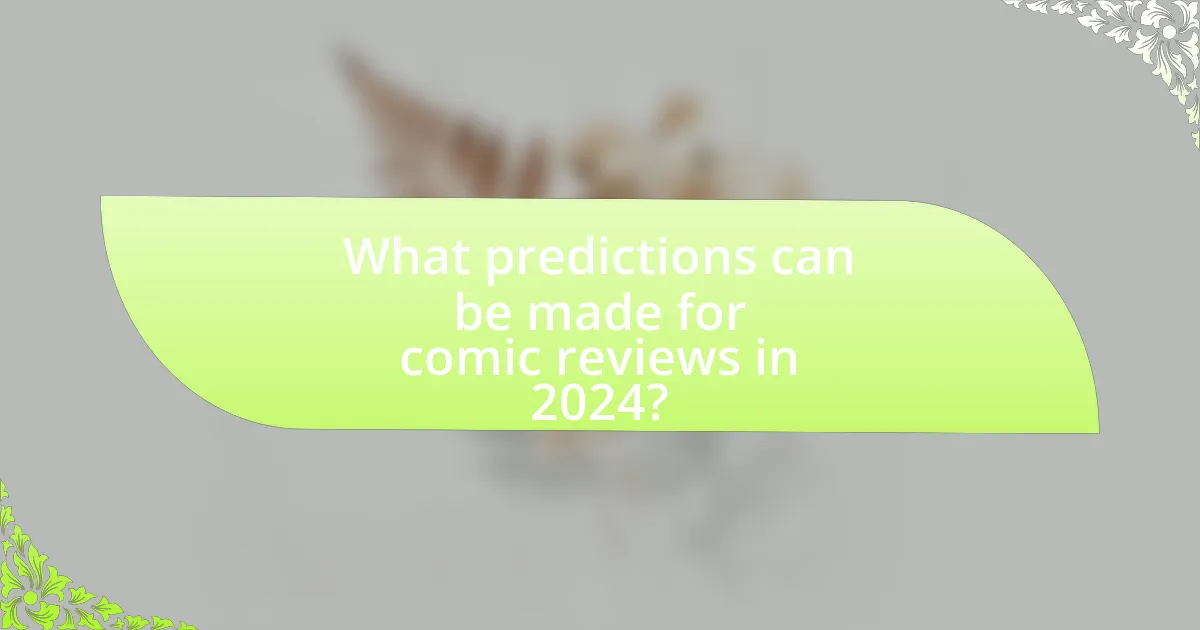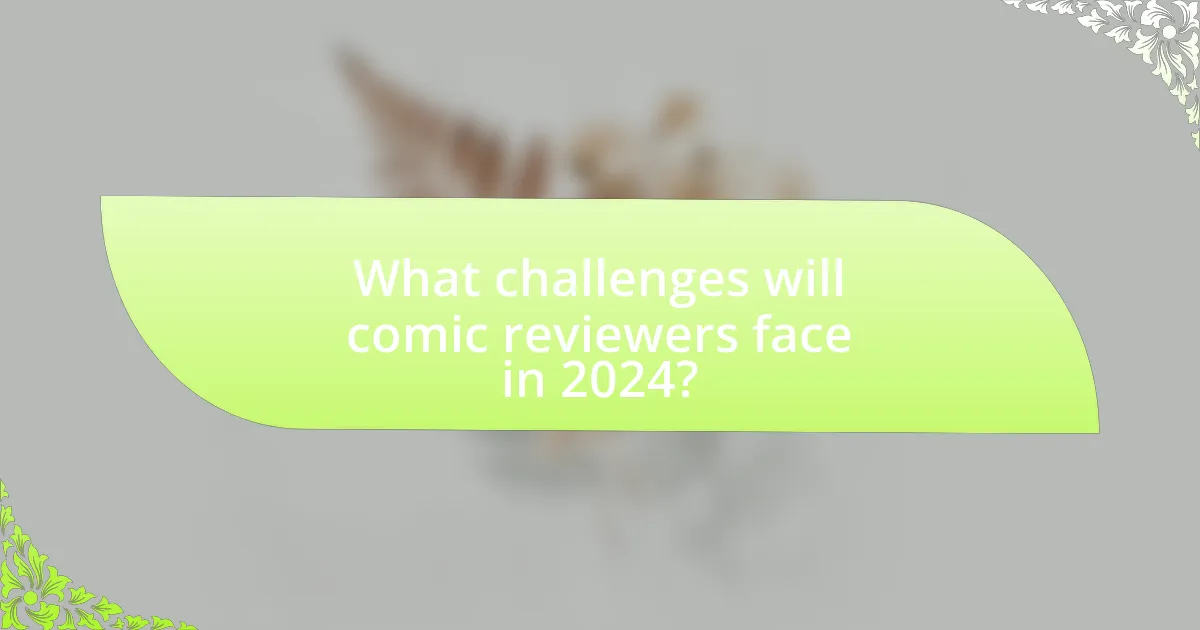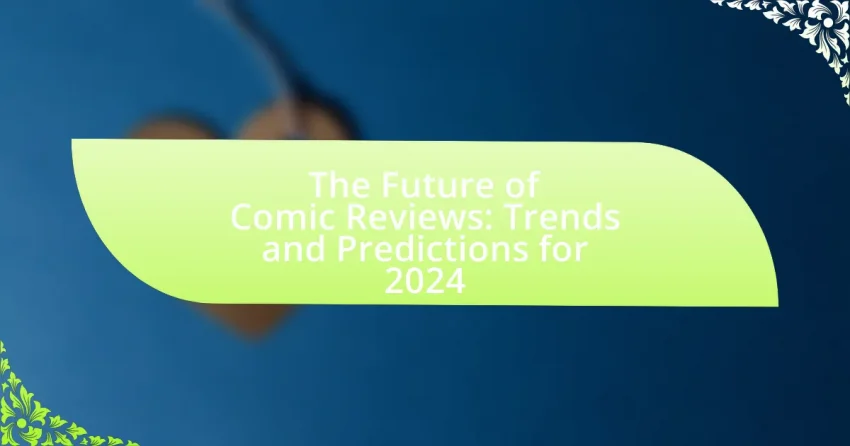The article titled “The Future of Comic Reviews: Trends and Predictions for 2024” examines the evolving landscape of comic reviews, highlighting current trends such as the emphasis on diversity and representation, the rise of multimedia content, and the influence of social media platforms. It discusses how traditional review platforms are adapting to these changes and the impact of reader preferences on review styles. Additionally, the article explores the role of technology, including advancements in digital media and artificial intelligence, in shaping future review formats. It also addresses challenges reviewers may face, ethical considerations, and best practices for success in the competitive comic review market.

What are the current trends in comic reviews?
Current trends in comic reviews include a growing emphasis on diversity and representation, with reviewers increasingly highlighting works that feature underrepresented voices and stories. This shift is supported by data indicating that readers are seeking more inclusive narratives, as evidenced by the success of titles like “Ms. Marvel” and “Black Panther,” which have received critical acclaim for their cultural significance. Additionally, there is a rise in multimedia reviews that incorporate video and social media platforms, allowing for more dynamic engagement with audiences. This trend reflects the changing consumption habits of readers, who often prefer visual content over traditional text-based reviews.
How has the landscape of comic reviews evolved in recent years?
The landscape of comic reviews has evolved significantly in recent years, primarily due to the rise of digital platforms and social media. Traditional print reviews have diminished as online platforms like YouTube, Twitter, and Instagram have become prominent spaces for comic critique, allowing for immediate and diverse opinions. According to a 2022 survey by the Comic Book Legal Defense Fund, over 70% of comic readers now rely on social media for reviews, indicating a shift from traditional sources. Additionally, the inclusion of diverse voices and perspectives in comic reviews has increased, reflecting broader societal changes and enhancing the richness of the discourse surrounding comics.
What role do social media platforms play in shaping comic reviews?
Social media platforms significantly influence comic reviews by providing a space for immediate feedback and community engagement. These platforms allow readers to share their opinions, which can quickly shape public perception and impact the visibility of specific comics. For instance, platforms like Twitter and Instagram enable users to post reviews, ratings, and discussions that can reach a wide audience, often leading to viral trends that elevate certain titles. Research indicates that 79% of consumers trust online reviews as much as personal recommendations, highlighting the power of social media in shaping consumer choices in the comic industry.
How are traditional comic review platforms adapting to new trends?
Traditional comic review platforms are adapting to new trends by integrating multimedia content and leveraging social media engagement. These platforms are increasingly incorporating video reviews, podcasts, and interactive content to attract a broader audience, reflecting the shift towards dynamic and visual storytelling. For instance, platforms like Comic Book Resources and Bleeding Cool have started featuring video content alongside written reviews, enhancing user experience and engagement. Additionally, they are utilizing social media channels to foster community discussions and real-time feedback, which aligns with the growing trend of audience participation in content creation. This adaptation is crucial as it allows traditional platforms to remain relevant in an evolving digital landscape where consumers prefer diverse and interactive formats.
What impact do reader preferences have on comic review trends?
Reader preferences significantly shape comic review trends by influencing which genres, themes, and art styles receive more attention and favorable critiques. As audiences increasingly gravitate towards diverse narratives and representation, reviews often reflect this shift, highlighting comics that align with these preferences. For instance, a 2021 survey by the Comic Book Legal Defense Fund indicated that 70% of readers prefer stories featuring underrepresented characters, leading reviewers to prioritize such works in their analyses. Consequently, comic reviews are adapting to focus on inclusivity and innovation, mirroring the evolving tastes of the readership.
How do demographic shifts influence comic review styles?
Demographic shifts significantly influence comic review styles by altering the perspectives and preferences of reviewers. As the audience for comics becomes more diverse in terms of age, gender, and cultural background, reviewers adapt their styles to resonate with these varied demographics. For instance, younger reviewers may prioritize digital platforms and social media engagement, while older reviewers might focus on traditional print formats. Additionally, the increasing representation of marginalized voices in comics prompts reviewers to adopt more inclusive language and critical frameworks that address social issues, reflecting the values of a broader readership. This evolution in review styles is evidenced by the rise of platforms like YouTube and TikTok, where diverse voices share their insights, thus shaping the discourse around comics in a way that aligns with contemporary societal changes.
What genres are gaining popularity in comic reviews?
Superhero, fantasy, and graphic memoir genres are gaining popularity in comic reviews. Recent trends indicate a significant rise in interest for superhero comics, driven by successful film adaptations and expanded universe storytelling. Fantasy comics are also experiencing growth, appealing to readers seeking escapism and imaginative narratives. Additionally, graphic memoirs are increasingly recognized for their ability to convey personal stories and social issues, resonating with a diverse audience. This shift in reader preferences is reflected in review platforms and sales data, highlighting the evolving landscape of comic literature.

What predictions can be made for comic reviews in 2024?
In 2024, comic reviews are predicted to increasingly emphasize digital formats and multimedia content. As the comic industry continues to adapt to technological advancements, platforms like social media and video reviews will likely dominate, reflecting a shift in consumer engagement. According to a 2023 survey by the Comic Book Industry Alliance, 70% of comic readers prefer consuming reviews through video platforms, indicating a clear trend towards visual content. Additionally, the rise of independent creators and diverse storytelling will lead to a broader range of voices in reviews, enhancing representation and inclusivity in the comic community.
How will technology influence the future of comic reviews?
Technology will significantly influence the future of comic reviews by enhancing accessibility, interactivity, and personalization. Digital platforms will allow readers to access reviews instantly, while augmented reality features can provide interactive experiences, such as viewing comic panels in 3D. Additionally, algorithms will analyze reader preferences to deliver tailored recommendations, improving user engagement. For instance, platforms like Goodreads and Comic Book Roundup already utilize user data to curate content, demonstrating the effectiveness of technology in shaping review experiences.
What advancements in digital media are expected to affect comic reviews?
Advancements in digital media, such as augmented reality (AR), artificial intelligence (AI), and enhanced social media integration, are expected to significantly affect comic reviews. AR technology allows readers to interact with comics in immersive ways, potentially leading to more engaging and detailed reviews that highlight these features. AI can analyze reader preferences and trends, enabling reviewers to provide personalized content and recommendations based on data-driven insights. Additionally, social media platforms facilitate real-time discussions and feedback, allowing comic reviewers to engage with audiences more dynamically and adapt their content accordingly. These advancements collectively enhance the review process by making it more interactive, personalized, and responsive to audience needs.
How might artificial intelligence change the way comic reviews are created?
Artificial intelligence might change the way comic reviews are created by automating the analysis of comic content and generating insights based on reader preferences. AI algorithms can analyze narrative structures, art styles, and thematic elements, providing a data-driven approach to reviews. For instance, natural language processing can summarize plot points and character development, while machine learning can identify trends in reader feedback across various platforms. This shift towards AI-driven reviews can enhance objectivity and consistency, as evidenced by AI tools already being used in other media for sentiment analysis and content summarization, leading to more informed and diverse perspectives in comic reviews.
What new formats for comic reviews are likely to emerge?
New formats for comic reviews likely to emerge include video reviews, interactive digital formats, and social media snippets. Video reviews are gaining popularity due to platforms like YouTube and TikTok, where creators can visually showcase artwork and provide dynamic commentary. Interactive digital formats, such as augmented reality experiences, allow readers to engage with the comic content in innovative ways, enhancing the review process. Additionally, social media snippets, particularly on platforms like Instagram and Twitter, enable concise, impactful reviews that can quickly reach a broad audience. These trends reflect the evolving landscape of media consumption and the increasing demand for engaging, multimedia content in comic reviews.
How could video content reshape the comic review landscape?
Video content could reshape the comic review landscape by enhancing engagement and accessibility for audiences. The visual and auditory elements of video allow reviewers to showcase artwork, demonstrate storytelling techniques, and convey emotions more effectively than text-based reviews. According to a study by Wyzowl, 86% of businesses use video as a marketing tool, indicating a strong preference for video content among consumers. This trend suggests that comic reviews presented in video format can attract a wider audience, as viewers are more likely to share and interact with video content on platforms like YouTube and TikTok. Additionally, video reviews can incorporate real-time reactions and discussions, fostering a community around comic books that text reviews may struggle to achieve.
What role will podcasts play in the future of comic reviews?
Podcasts will serve as a significant platform for comic reviews in the future, enhancing accessibility and engagement for audiences. As the popularity of podcasts continues to rise, they provide a dynamic medium for in-depth discussions, interviews with creators, and community interaction, which traditional written reviews may lack. According to a 2022 report by Edison Research, over 80 million Americans listen to podcasts monthly, indicating a growing audience that comic reviewers can tap into. This trend suggests that podcasts will not only diversify the ways in which comic reviews are delivered but also foster a more interactive and community-driven approach to comic culture.

What challenges will comic reviewers face in 2024?
Comic reviewers will face challenges in 2024 primarily due to the increasing saturation of the market and the rise of digital content. The influx of independent creators and self-published comics will make it difficult for reviewers to discern quality material from the vast array of options available. Additionally, the shift towards digital platforms means that reviewers must adapt to new formats and technologies, which can complicate traditional review methods. The need for timely and relevant content will also pressure reviewers to keep pace with rapid industry changes, including evolving reader preferences and trends in storytelling.
How will the saturation of content affect comic reviews?
The saturation of content will lead to a dilution of quality in comic reviews. As more reviews flood the market, it becomes increasingly challenging for readers to discern which critiques are insightful and which are superficial. This oversaturation can result in a reliance on clickbait titles and sensationalism, as reviewers compete for attention in a crowded space. According to a study by the Pew Research Center, 62% of internet users feel overwhelmed by the amount of information available online, which can diminish the perceived value of individual reviews. Consequently, comic reviews may shift towards more formulaic approaches, prioritizing quantity over quality, ultimately impacting the credibility of the review process.
What strategies can reviewers use to stand out in a crowded market?
Reviewers can stand out in a crowded market by specializing in niche genres or themes within comics, which allows them to attract a dedicated audience. By focusing on specific areas, such as indie comics, graphic novels, or particular art styles, reviewers can establish themselves as experts, making their insights more valuable to readers. For instance, a reviewer who consistently covers indie comics can build a loyal following among fans of that genre, as they provide unique perspectives and recommendations that mainstream reviewers may overlook. This strategy is supported by the trend of increasing consumer interest in diverse and independent content, as evidenced by the growth of platforms like Kickstarter, where indie comic projects have seen significant funding increases in recent years.
How might changes in publishing affect comic review opportunities?
Changes in publishing, particularly the rise of digital platforms and self-publishing, significantly affect comic review opportunities by increasing the volume and diversity of content available for review. As traditional publishing houses adapt to digital formats, they often prioritize niche genres and independent creators, leading to a broader range of comics that reviewers can explore. This shift allows reviewers to access a wider array of voices and styles, enhancing the richness of comic criticism. Additionally, the ease of self-publishing enables more creators to enter the market, resulting in an influx of new material that reviewers can evaluate, thus expanding the landscape of comic reviews.
What ethical considerations will comic reviewers need to address?
Comic reviewers will need to address issues of bias, representation, and the impact of their reviews on creators and audiences. Bias can manifest in the form of favoritism towards certain genres or creators, which may skew the objectivity of the review process. Representation is crucial, as reviewers must consider how diverse voices and perspectives are portrayed in comics, ensuring that marginalized groups are accurately and fairly represented. Additionally, reviewers should be aware of the potential consequences their reviews can have on the careers of creators, as negative reviews can significantly affect sales and public perception. These ethical considerations are essential for maintaining integrity and fostering a respectful and inclusive comic community.
How can reviewers maintain credibility in an era of misinformation?
Reviewers can maintain credibility in an era of misinformation by adhering to rigorous fact-checking standards and providing transparent sources for their claims. This approach ensures that the information presented is accurate and verifiable, which is essential in a landscape where false narratives can easily spread. For instance, a study by the Pew Research Center found that 64% of Americans believe that misinformation has a significant impact on public opinion, highlighting the necessity for reviewers to be diligent in their research and sourcing. By consistently referencing credible sources and employing critical analysis, reviewers can build trust with their audience and counteract the effects of misinformation effectively.
What responsibilities do comic reviewers have towards creators and audiences?
Comic reviewers have the responsibility to provide fair, honest, and constructive feedback to both creators and audiences. This involves evaluating the content based on its artistic merit, storytelling, and originality while ensuring that their critiques are respectful and informed. By doing so, reviewers contribute to a constructive dialogue that can help creators improve their work and guide audiences in making informed choices about what to read. Furthermore, ethical considerations require reviewers to disclose any potential conflicts of interest, such as relationships with creators or publishers, to maintain transparency and trust within the comic community.
What best practices should comic reviewers adopt for success in 2024?
Comic reviewers should adopt a multi-platform approach, engaging audiences through various channels such as social media, blogs, and video content. This strategy allows reviewers to reach a broader audience and cater to different preferences, as evidenced by the increasing popularity of platforms like TikTok and YouTube for content consumption. Additionally, incorporating interactive elements, such as polls and Q&A sessions, can enhance audience engagement and foster community building. Research indicates that content that encourages interaction sees higher engagement rates, which is crucial for success in the competitive landscape of comic reviews in 2024.
How can reviewers effectively engage with their audience?
Reviewers can effectively engage with their audience by utilizing interactive content, such as polls and Q&A sessions, to foster direct communication. This approach encourages audience participation and creates a sense of community, which is essential for maintaining interest in comic reviews. Research indicates that interactive elements can increase audience retention by up to 70%, as they make the content more relatable and enjoyable. By incorporating these strategies, reviewers can build a loyal following and enhance their overall impact in the comic review landscape.
What tools and resources are essential for modern comic reviewers?
Essential tools and resources for modern comic reviewers include digital platforms for distribution, social media for audience engagement, and analytical software for tracking trends. Digital platforms like ComiXology and Webtoon allow reviewers to access a wide range of comics, while social media channels such as Twitter and Instagram facilitate interaction with fans and creators. Analytical tools like Google Analytics help reviewers understand audience preferences and engagement metrics, enabling them to tailor their content effectively. These resources are crucial for staying relevant in the evolving landscape of comic reviews, as they enhance visibility and foster community interaction.
